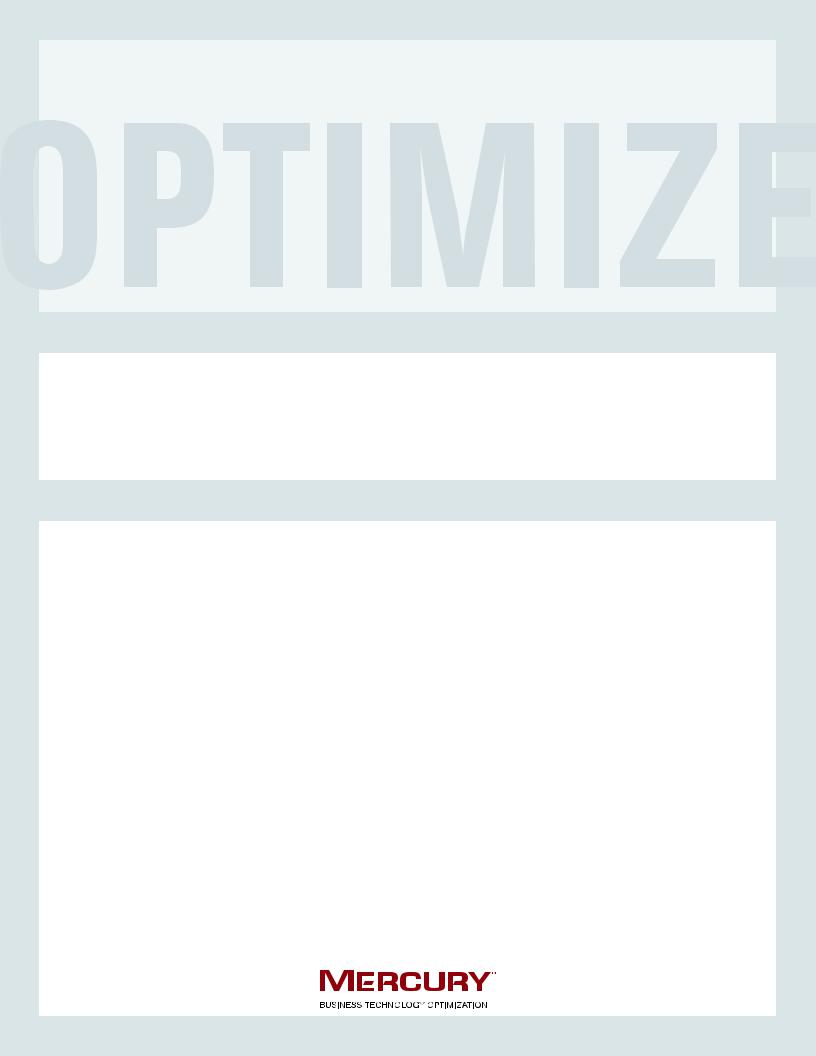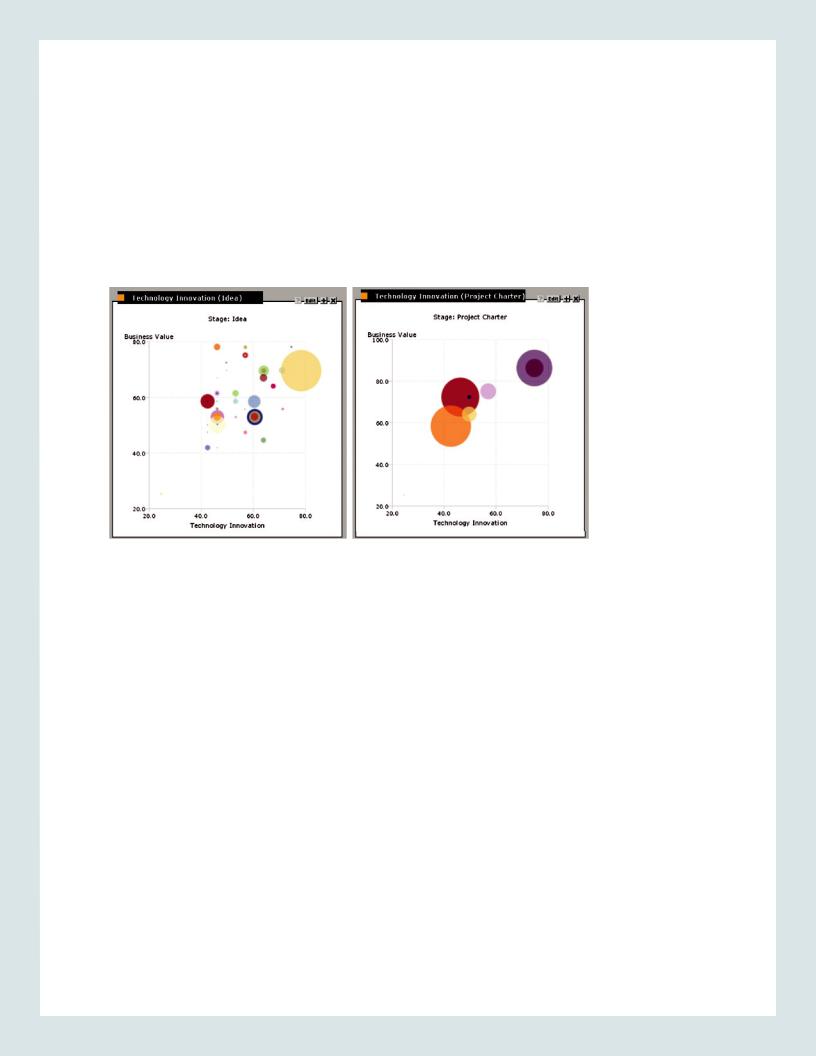
MercuryWhitepaper
.pdf
IT GOVERNANCE CHALLENGES
AND BEST PRACTICES

Overview
“We’ve always done it this way.”
That simple sentence has probably been uttered millions of times in businesses around the world. Usually, the people who say it are sincere, thinking the way they work adds value to the business. Trouble is, you rarely hear this phrase in businesses that deliver the most value to their customers and shareholders. Instead, “this way” is usually a “code phrase” for informal, undocumented approaches to completing tasks.
It was never an optimal approach. Today, it’s not even acceptable, because business is now driven by technology, which—properly applied—constantly offers opportunities for efficiencies, savings, and improved performance. Realizing those opportunities requires consistent processes—predictable, repeatable, enforceable. That is why there is so much momentum in the IT world toward strong process frameworks, such as IT Infrastructure Library (ITIL), and toward IT governance—digitizing and automating processes to run IT like a business. As this paper explains, the two are complementary.
The results of effective IT governance can be transformational. The leading academic researcher on IT governance, Professor Peter Weill of MIT Sloan School of Management, estimates that companies with the most effective IT governance systems enjoy 10 to 25 percent higher profitability1.
1 Research briefing How Top Performers Govern IT, October 2003
TABLE OF CONTENTS |
|
Overview.................................................................................................... |
2 |
Defining IT Governance...................................................................... |
3 |
The Challenge of Change................................................................. |
3 |
Show Me the Value............................................................................... |
4 |
Make it About Business...................................................................... |
5 |
ITIL and IT Governance....................................................................... |
6 |
Assess Where You Stand................................................................... |
7 |
Phased Deployment............................................................................. |
7 |
Honor Culture, but Don’t Be Trapped by it............................... |
8 |
Ease Pain Points First.......................................................................... |
9 |
Seven Critical Success Factors.................................................. |
10 |
Expect Success.................................................................................... |
11 |


Gaining visibility and control over the demands being made on IT, the portfolio of IT projects, and the rollout of strategic changes at the enterprise level allows companies to:
•Reduce the cost of day-to-day operations
•Improve overall operational efficiency and consistency
•Free more resources for strategic initiatives that improve competitiveness
•Choose those initiatives far more wisely, working on the right things, not the wrong things
•Bring those initiatives to market faster with less risk
•Bring IT into close alignment with business priorities
This paper helps chart the path from “always done it this way” to effective process frameworks and IT governance. It outlines some of the most common challenges to effective IT governance implementation and discusses some of the best practices embraced by companies that have achieved it.
Defining IT Governance
In their book, IT Governance (Harvard Business School Press, 2004), Weill and co-author Jeanne W. Ross define IT governance as “specifying the decision rights and accountability framework to encourage desirable behavior in the use of IT.” They identify three questions that must be addressed to achieve effective IT governance (p.10):
1.What decisions must be made to ensure effective management and use of IT?
2.Who should make these decisions?
3.How will these decisions be made and monitored?
Weill and Ross find that the third question in particular is often given short shrift by companies, or ignored altogether. They make it clear that process is critical to success—transparent processes that are both understood and accepted, by IT managers and participants in the process, and by the business-side team members who interact with IT.
Another way to define IT governance is by saying what it is not. Richard G. Bhanap of Accenture, a leading IT governance expert, holds that “IT governance is not the model to manage the IT department. IT governance is the model by which business manages its use of IT.”2
Both of these definitions of IT governance revolve around the business itself, rather than the encapsulated operations of the information technology group. That is a difficult change for some to embrace.
The Challenge of Change
Virtually every manager in business today has encountered employees who held up organizational change by insisting on continuing with the “old way” of doing something, even though the success of the “new way” depends on universal adoption.
Lisa Fitting, IT governance manager at Giant Eagle, saw something similar as she began her implementation. “We got resistance within IT. Mostly it was ‘I don’t have time to do this; I prefer the system I use now.’”
“The organizational changes associated with many systems are wrenching. They not only require that individuals change their habits; they typically require a new understanding of organizational processes.”
— Peter Weill and Jeanne W. Ross, IT Governance, p.44
2 Presentation at Mercury World 2005, October 2005


Even business titans run into this. Oracle CEO Larry Ellison depends on a software-driven business dashboard to give him a “heads up” view of metrics that help him make decisions. But according to a recent BusinessWeek article (February 13, 2006), 20 percent of his sales team members aren’t yet entering their leads. “Ellison has become more convinced than ever that dashboards are the way of the future,” BusinessWeek reported. “He just wishes more of his employees thought the way he does… ‘People have to be persuaded that it’s right,’” he says.
Show Me the Value
CIOs must be willing to take the lead in the search for value-creating IT processes. If they are not, others—real experts—are glad to do so, in language that resonates with CEOs.
Accenture, for example, talks of “IT value creation levers” and the amount each can contribute to earnings per share. These include “reduce IT cost base and enhance IT effectiveness,” “improve current business model and processes through IT,” and “grow top line with new IT-enabled products and enhanced capabilities.”3 When CIOs frame the discussion with CEOs and CFOs in this manner, they get their attention.
There’s certainly plenty of room for improvement. According to a 2005 Accenture IT Productivity survey by Standish Group, cited by Bhanap, 54 percent of all IT projects are “challenged,” and 18 percent fail completely. Further, 56 percent of business executives surveyed, along with 38 percent of IT executives, felt that IT is under-delivering against the investment the business makes in it. And just under half of both business and IT managers said their company “did not spend much time ensuring IT spend is linked to business value.”
Proving business value is what Xcel Energy did when they instituted IT governance in the wake of acquisitions that left them with siloed, disconnected IT groups.4 Xcel Energy leaders reasoned that with a consolidated IT delivery system driven by consistent, enforced processes and reliable, real-time data, they could deliver considerably more IT value to the business.
Xcel Energy started its IT transformation by setting up a Program Management Office (PMO) to manage delivery of projects and a formal portfolio management system for evaluating and prioritizing strategic IT projects. They identified the following essential ingredients:
•Clear and consistent governance policies, standards, and processes
•Automated core processes
•Support from project managers for the new processes
•Achieving and maintaining close alignment with business units on PMO goals and processes
•Mentoring project managers to facilitate use of the PMO
•Special emphasis on the financial management of projects
•“Practicing what we preach” by running the PMO initiative itself as a project
Xcel Energy IT leadership worked with business units to recast the helter-skelter project request process into a stage gate process, with a consistent, easy-to-understand set of requirements that take initiatives from idea to completion, and used a consistent economic value-add metric as a key criterion for project approval, as well as measurement of results.
The first stage allows employees to submit ideas to their business unit, which then evaluates them and decides which to sponsor for the next stage, in collaboration with the business unit’s technology executive (de facto CIO of the business unit). At this point, there is a “gate.” Business unit leaders chose the ideas for which they (not IT) will financially underwrite a short feasibility study. This first hurdle was only cleared by 12 percent of the first 300 ideas submitted when the new system was implemented, already creating a culture of rigor and discipline.
3Richard Bhanap, Presentation at Mercury World 2005, October 2005
4This story is recounted in detail in IT Portfolio Management: Unlocking the Business Value of Technology, by Bryan Maizlish and Robert Handler: John Wiley & Sons, Inc., 2005

The ideas that make it through this gate are evaluated using consistent metrics for scoring business value and technology innovation. Xcel Energy’s portfolio management system uses data entered and managed by project teams to plot these on bubble chart axes, with the estimated cost of the project used to determine the size of the “dot” (Figure 1).
A business-IT team evaluates candidate projects using a standardized template. Those demonstrating adequate value move forward into the business case stage, a funded project in and of itself, where some costs can be capitalized. This stage includes a detailed risk assessment and cost-benefit analysis, with financial estimates developed to within 10 percent (plus or minus) of final project costs.
Projects approved in this stage receive full funding, administered by IT from its central capital budget, which is partially allocated to individual business unit projects. However, a very specific set of funding rules gives the business units a strong incentive to choose projects carefully and fully participate in the evaluation of them. If they don’t, they risk losing part of their allocated funding to other business units.
Figure 1: Xcel Energy uses bubble charts to evaluate candidate projects in the first two stages. The right-hand chart shows how many low-value projects have already been rejected.
This evaluation process is made much easier through desktop dashboards for both business-side and IT managers, providing real-time status on requests and projects, while generating meaningful metrics. These consistent metrics facilitate “apples-to-apples” comparisons across business lines, making IT processes transparent to the business.
The Xcel Energy example demonstrates that by applying consistency and rigor to the quantification of value, and enforcing consistent processes that are understood by both business and IT, considerably higher value can be unlocked. After the first year of this system, Xcel Energy had stopped $8 million worth of projects deemed not likely to deliver business value, and had redeployed $10 million in capital to higher value projects. Further, through better front-end analysis and business case development, Xcel reduced project change requests by 21 percent.
Xcel Energy has moved forward to use this same process rigor and enforcement to standardize and automate the handling of routine requests made of IT, driving out costs and saving time, which in turn has allowed them to shift increasing amounts of funding from these day-to-day operational activities to the strategic project fund, aligning more closely to business priorities and needs. In fact, Xcel Energy was able to increase strategic spend from 37 percent to 57 percent.
In addition to the evaluation process based on business value and technology innovation, Excel Energy is in the process of evolving the way they evaluate ideas at this gate beyond the scoring method described. An effort is underway to add the linkage of assets to ideas allowing Excel Energy to add asset health and risk to the evaluation criteria for this gate.
Make it About Business
Weill and Ross point out that IT drives business success today more than ever, and that IT governance is now inextricably linked with business governance, both because of IT’s critical business role and because of regulations such as the Sarbanes-Oxley Act, as well as other industryspecific reporting requirements. The Xcel Energy example clearly demonstrates this. Integrating the business side into the IT decision-making

process made it easier to get everyone on board. In IT Governance, Weill and Ross acknowledge that this is often difficult, and requires incentives. “Changing compensation structures is often a requirement for motivating new behavior, but changing compensation is not enough. Employees implementing change … may need both training and structural support.” (p.44)
Those who have successfully implemented IT governance systems, both consultants and in-house teams, cite the importance of building familiarity and confidence in a new system among stakeholders step by step. The Acuity Group, which helps companies implement IT governance, urges the methodical gathering of requirements, including early identification of user roles, followed by detailed interviews with all stakeholders in the process, to drive requirements for reporting, request types, and workflows. This is followed by an iterative review cycle of processes modeled after the initial interviews, to identify improvements.
It is especially important to treat this effort as a “clean sheet of paper,” lest it turn into the perpetuation, through automation, of outdated, overly complicated legacy processes. During process design, each proposed step should be scrutinized closely to assure that it is truly needed. Using IT governance software with a builtin, easily configurable workflow engine lets all stakeholders see the process visually. This simple act highlights redundant or overly complicated steps and allows easy simplification of the process, usually saving considerable time.
Acuity then recommends rapid prototyping—identification and modeling of key process steps, followed by rapid review cycles by stakeholders, walking through the prototype to set expectations on key functionality and usability. The prototype, with key functionality approved, then becomes the working model.
ITIL and IT Governance
“In order for ITIL to be effective, you need to use it as the foundation to your own processes. Based on what I have seen and what Mercury IT Governance Center has done for us, including the flexibility that the tool gives us, I would say that Mercury is on the right track. I am a big fan of the
Mercury products and their approach to Business Technology Optimization.”
–Christopher Grant, Deputy CIO, Chicago Public Schools Office of Technology Services
Note the consistent emphasis on efficient, repeatable processes in these examples. Leading CIOs recognize there is no other viable way to meet the increasing demands of the business. So their growing embrace of IT operational frameworks should be no surprise. Far and away, their preferred framework is ITIL.5 The ITIL approach is quickly becoming the de-facto standard for IT service delivery. Forrester expects that implementation levels in $1 billion-plus companies will grow from 13 percent today to around 40 percent by the end of 2006.6
ITIL, originally developed in the UK, is a library of best-practice IT processes to improve the efficiency and effectiveness of IT operations, thus reducing costs and risk of day-to-day operations. These operational activities consume between two-thirds and three-quarters of total IT budgets in most companies. Improving their efficiency, as companies like Xcel Energy have done, frees up more IT spend for the strategic initiatives that grow and transform the business. And because ITIL is widely accepted as a standard worldwide, its implementation is harder to resist for IT team members skeptical of change.
ITIL commonly focuses on 11 service delivery and support processes, but is intended to provide only the “what”—the process framework for improved IT services—not the “how.” This is where ITIL dovetails with IT governance software, which provides specific processes tuned to an organization’s needs, along with automated execution capabilities, establishment, and enforcement of roles and responsibilities among participants in the process, real-time dashboard visibility into progress of specific tasks, and automatic creation of metrics for results assessment.
The “sweetest spot” where ITIL and IT governance software meet is change configuration, one of the most time-consuming, budget-draining processes in most companies. Linde Gas AG, one of Germany’s top blue-chip companies, is committed to ITIL best practices, and used them to standardize operating procedures across national borders in conjunction with an SAP R/3 upgrade. An important part of this initiative was the need to formalize, standardize, and automate the process of going live with new or modified electronic business processes in their SAP
5Gartner cites a December 2004 Data Center Conference survey showing 31 percent of respondents chose ITIL as the model they planned to use as the standard for IT operations. The next choice was Six Sigma with 7 percent, followed by CobiT with 4 percent and ISO 9000 and CMM with 3 percent each. There is, of course, overlap in the scope of these models, and many planned to use a combination.
6Forrester white paper, Point Solutions for Enterprise Infrastructure Management, by Thomas Mendel, Ph.D., and Jean-Pierre Garbani, TECH CHOICES, July 20, 2005.

|
|
1 |
|
2 |
|
3 |
|
4 |
|
5 |
|
|
Informal |
|
Defined |
|
Managed |
|
measured |
|
optimized |
|
|
|
|
|
|
|
|
|
|
|
Portfolio |
• |
Ad hoc planning |
• |
Manual planning |
• |
Automated processes |
• |
Advanced what-if |
• |
Score cards |
Management |
|
|
• |
Subjective ranking |
• |
Objective project ratings |
|
analysis |
• |
Real-time planning |
|
|
|
• |
Budget-driven |
• |
Planned vs. actual |
• |
Benefits realization |
• |
Full portfolio |
|
|
|
|
|
• |
Resource planning |
• |
Assets/TCO analysis |
|
optimization |
|
|
|
|
|
|
|
• |
KPI-driven |
|
|
Project Visibility and |
• |
Manual reporting |
• |
Spreadsheet-based |
• |
Milestone-level |
• |
Project baselines |
• |
Advance skills |
Control |
|
|
|
tracking and reporting |
|
reporting |
• |
Resource supply/ |
|
management |
|
|
|
|
|
• |
Project templates |
|
demand balancing |
• |
Planning by leveraging |
|
|
|
|
|
• |
Resource management |
• |
Earned value analysis |
|
knowledgebase |
|
|
|
|
|
• |
Project-control process |
|
|
|
|
IT Services |
• |
E-mail/phone calls |
• |
Traditional help desk |
• |
Employee self service |
• |
SLA management |
• |
Single point of entry |
Automation |
|
|
• |
Multiple entry points |
• |
Full transparency |
• |
Customer satisfaction |
|
for demand |
|
|
|
• |
Information silos |
• |
Best practices (ITIL) |
|
tracking |
• |
Integration with |
|
|
|
|
|
|
|
• |
Effort vs. service |
|
Portfolio Management |
|
|
|
|
|
|
|
|
tracking |
|
|
|
|
|
|
|
|
|
• |
More automation |
|
|
Application Change |
• |
Ad hoc/no audit trail |
• |
Paper-based and |
• |
Repeatable SDLC |
• |
Quality/efficiency |
• |
Cost tracking |
Management |
|
|
|
manual |
|
processes |
|
metrics |
• |
Enterprise standards |
|
|
|
|
|
• |
Automated deployments |
• |
Release management |
|
|
|
|
|
|
|
• |
Tight environment |
|
|
|
|
|
|
|
|
|
|
control |
|
|
|
|
|
|
|
|
|
|
|
|
|
|
|
Figure 2. A methodical assessment of an organization’s current standing in these four critical areas of IT governance commonly reveals where needs are greatest, and where the quickest value can be realized in pilot programs of IT governance systems.
R/3 environment. They selected IT governance software that provided that ITIL interface, along with support for every step in the SAP Transport Management System, with no gaps. As in every other example cited in this paper, the software came from Mercury, in this case Mercury Deployment Management™. Linde executive Thomas Steinich called Mercury “the superior solution in just about every respect,” enabling Linde to “build a sensible and efficient structure for the entire change management process” around ITIL best practices.
Mercury’s IT governance software also provides cross-process integration between ITIL processes and frameworks adopted for other purposes, such as CobiT, CMMi, and Six Sigma.
Assess Where You Stand
An important first step in achieving effective IT governance is making a hard-nosed assessment of where you are. One of the most common pitfalls in implementing IT governance is trying to run before you can walk. The well-known CMMi (Capability Maturity Model) is widely used to measure overall levels of IT maturity within organizations. Mercury has developed something of a similar model focused directly on IT governance (Figure 2). It provides an easy-to-use scorecard of where an organization stands in its capabilities in the four key areas of IT governance execution: project portfolio management; project visibility and control; IT services automation; and application change management.
Phased Deployment
Another key tenet of successful IT governance implementation is phased deployment. The temptation is to try to tackle everything at once and “get it over with.” This is generally a ticket to failure. Embedded habits take time to break, as even Larry Ellison found out. There are two basic ways toward effective phased deployment: pilot projects and pilot groups.
With pilot projects, the new system is implemented first on projects where there is time to learn the new system properly, and where there are not too many interfaces with other projects. This keeps the new system as easy to absorb as possible, giving initial users a taste of success, which they then spread around the organization. Starting with pilot projects also allows phasing in of a PMO or portfolio management system without the obligation to spend a great deal of time converting legacy projects and data to function in the new system. Many companies have run new and old systems side by side for a time to foster this transition.

Pilot groups follow much the same philosophy, except that here the system is rolled out to cover multiple IT governance functions within a single group, which might be a business unit IT group, an application deployment team, or other self-contained group. Here again, phased deployment allows a company to bite off a manageable chunk of IT governance, gaining experience within an easily manageable scope, and identifying any problems with processes or tools at an early stage.
In both types of phased deployment, piloting IT governance allows organizations to be sure they have provided enough training before the operation as a whole is too dependent on the new system. Building these early successes encourages further adoption throughout the organization. Additionally, carefully chosen pilot programs or groups allow the organization to begin running comparisons between automated and non-automated processes, to measure savings in time and money. The data gathered here provide proof of the concept’s value, and assist in identifying future enhancements as well.
Honor Culture, But Don’t Be Trapped By It
Instituting effective IT governance requires dealing with the “c-word.” The culture of a company—“the way we do things here”—can be a tremendous driver for business success. It can also be—and often is—a giant resistor that dampens positive change. Immeasurable amounts of energy have been dissipated trying to change embedded habits and methods that hid behind the cloak of “culture.”
One way to broadly categorize corporate cultures is competitive versus collaborative. Today, worldwide, the trend is toward collaborative culture, especially in the sharing of information. The attitude that “information is power” lingers in some dark company corners. In some disciplines, such as sales, where compensation is directly related to personal contacts and initiative, it is arguable that the status quo has value. In most cases, though, managements are trying to rid the company of these attitudes in order to unlock the power of teamwork leveraged by technology. IT governance requires teamwork and information sharing to succeed.
In implementing IT governance, companies must offer adequate training and orientation, and address concerns raised by workers. However, there must be a “sunset” on this period, after which everyone must embrace the new system. Some IT groups are reticent to do this, perhaps because of the reluctance of technology professionals to sacrifice their culture of perceived independence for what they consider regimentation.
Still, it is hard to imagine a company that has just installed an enterprise resource management (ERP) system allowing a lone accountant to remain in a corner with a ledger and green eyeshade just because he or she is more comfortable with this system. Or continuing to send regular paychecks to an isolated few employees who refuse to enter their hours into a new automated timecard application.
As in other initiatives, leadership must come from the top. If a CIO acts lukewarm about an IT governance system, or allows individual managers to “opt out,” the message is sent loud and clear around the organization that the new system might “go away” if it is ignored long enough. “We’re getting some support from the CIO, but it’s not a daily thing,” says a manager in a retail company working on an IT governance implementation. “He’ll make quarterly statements, but on a daily basis it’s not there. It’s incredibly important to have audible, visible mandates from the CIO—that people are being reminded on a constant basis that this is the new direction.”
Companies that have gained the most value from IT governance are those that have mandated and enforced its use. Unless this happens, the data gathered by the automated system is incomplete, causing metrics that are less than meaningful. This can lead to wrong decisions based on poor information, which in turn delivers less value delivered to the organization and a sense that the system is somehow a “failure.”

This requirement for universal usage drove Bob Moore, CIO of PaeTec, a fast-growing telecommunications company in Rochester, New York. As PaeTec was beginning its growth spurt several years ago, Moore realized that the “adhocracy” that handled IT requests from the business could not scale in line with anticipated business growth, posing a real drag on that growth. Besides, Moore was weary of people coming up to him in the cafeteria line to ask him for “favors”—which usually meant just getting something done outside the normal paper process.
Moore implemented a comprehensive demand management system through IT governance software that required requestors to use the browser-based system to enter his or her request. Phone calls to “buddies,” yellow sticky-notes, and other common methods of the past were shut down. Not without grumbling. The workers with friends in IT lost their special standing. Some IT workers felt they weren’t indispensable to their friends anymore. But the system took hold and was methodically extended across the company, even to processes in other groups, such as Human Resources and Marketing. Combined with effective implementation of IT governance over other aspects of IT, PaeTec now runs its IT at about half the industry average cost, as a percentage of revenue.
Ease Pain Points First
Sometimes, a combination of cultural resistance and cost considerations leads companies to outsource significant portions of their IT operation, either within their country of operation, or offshore. In doing so, CIOs usually find that outsourcing companies, for whom IT is the business, can help lead them into effective IT governance, because they already practice it themselves and make a practice of looking for ways to improve it.
For example, Birlasoft, an innovative India-based IT services organization, built its client base, which included GE, through rigorous pursuit of quality in its processes and execution, including both CMMi and Six Sigma. So it thought it was on the right track, but it found that maintaining its CMMi Level 5 maturity required extensive data collection and analysis, which had to be done manually, leading to errors, running up costs, and overloading both project managers and developers.
The same problems were hampering Birlasoft’s Six Sigma initiative. One of the most important Six Sigma tools, known as DMAIC (Define, Measure, Analyze, Improve, and Control) demands rigorous adherence to process, but manual data gathering conflicted with project needs.
Birlasoft Chief Operating Officer Kamal Mansharamani recalled, “Project managers would come to me and ask, ‘Do you want to meet the [customer’s] deadline, or do you want to follow the process?’ Our customers were telling us they couldn’t see the benefits of our Level 5 capability; they had no visibility into the work we were doing for them. I realized that we needed to transform our business by digitizing and automating IT with a single transaction system-of-record.”
When implementing an enterprise IT governance solution, Birlasoft took it one step at a time. They wanted something transformational, but their own experience taught them to look for “quick wins” to build confidence in the system. They started with areas where they knew they had real pain. Two such areas were project management and customer visibility. Project management costs were eating up too much of the budget: 18 percent on average.
Customers, most of them 10,000 miles away, didn’t know where their projects stood, and old-fashioned communication was hampered by the time zone difference. The IT governance software immediately slashed manual data collection and analysis, and speeded project pace by automating many steps and enforcing action on others. Within a few months, project management costs had been cut by more than two-thirds, from 18 percent to 5 percent of project budgets. And customers knew exactly where their projects stood thanks to access to their own real-time IT governance dashboards.
Thanks to the flexibility of Mercury IT Governance Center, Birlasoft easily created a series of customized workflows for development projects, support and maintenance projects, quality assurance (testing) projects, and infrastructure support projects. All of these adhered to Birlasoft’s CMMi Level 5 processes and made it easy to measure performance, productivity, and execution—measurements that had been unreliable and difficult to extract in the old manual system. This reliable, automated data flow greatly facilitated achievement of Six Sigma by supporting key tools such as DMAIC and DFSS (Design for Six Sigma).
That initial application, coupled with the implementation of Six Sigma practices facilitated by Mercury IT Governance Center software, saved Birlasoft $1 million in just six months.

Seven Critical Success Factors
Software Quality Solutions (SQS), a successful implementer of IT governance for its clients, has distilled seven critical success factors for achieving effective IT governance implementations. As we have seen in this paper, these are widely accepted as important by companies that have had successful IT governance implementation. We present them here with our comments.
1.Get executive sponsorship.
—The higher in the organization the better. If IT governance is seen as “optional,” it won’t work.
—Certainly on the IT side, the CIO should be a visible, vocal champion.
—On the business side, it would be ideal to have a C-level executive. CFOs in particular are powerful persuaders because it’s clear they’re speaking on behalf of the company’s bottom line.
2.Put client resources on the team.
—This is spoken from a consultant’s point of view, but the concept is equally valid for internal implementations.
—Success depends on strong teamwork and alliances across IT and the business side.
—By exposing both key business-side and IT users to the system early, taking the time to acquaint them to it, and explaining its benefits, you create champions who carry the story across the company.
3.Understand the problem.
—Aim before you fire. Take the time to determine where you’re starting from in the Capability Maturity Model. If you’re at level one, you have basic process work to do before you are ready to implement a transformational solution.
—Pick an attainable target to start with, ideally a particular pain point that is costing you time and money. It might be poor project performance resulting from a lack of visibility and control; slow, labor-intensive handling of routine business requests of IT; mistake-prone application change management that endangers your all-important business systems; a lack of standards for comparing the potential value of various projects in the IT portfolio; or a combination of these. Start with one and work from there.
4.Envision the solution.
—Think hard about what you want to accomplish initially. Set goals high, but don’t make them unattainable—it demoralizes people.
—Make sure your requirements are clearly defined and universally understood among all the stakeholders.
—Stick to the original plan once you’ve adopted it. Keep the vision firmly fixed in your mind. Don’t listen to the siren song of scope creep. Achieve your mission first, and then build on success.
—Focus on process improvement areas. Look for every opportunity to streamline workflow and remove steps. If you’re not already using a standard framework such as ITIL, you should seriously consider embracing it. It will help you employ processes in a proven and effective way.
5.Pick the right software solutions for the right reasons.
—Recognize that successful IT governance requires clear, enforceable processes and standards. Your software should provide real-time visibility of projects and activities in easy-to-use desktop dashboards. It should also include built-in enforcement mechanisms.
—Think beyond your initial implementation. Make sure the software is built to be an enterprise-level solution—scalable, in other words. Check to see that it is easily configurable and flexible in its use.
—Also be sure the software is compatible with, and leverages, best practice frameworks such as ITIL and CMMi, and supports such quality issues as Six Sigma.
